Cartellate pugliesi is a typical Christmas dessert from the “heel of the boot” - Apulia.
Cartellate are super crispy and bubbly deep-fried dough pinwheels that resemble the shape of a rose. Traditionally they are dipped in vincotto or honey but can also be chocolate covered or simply dusted with powdered sugar.
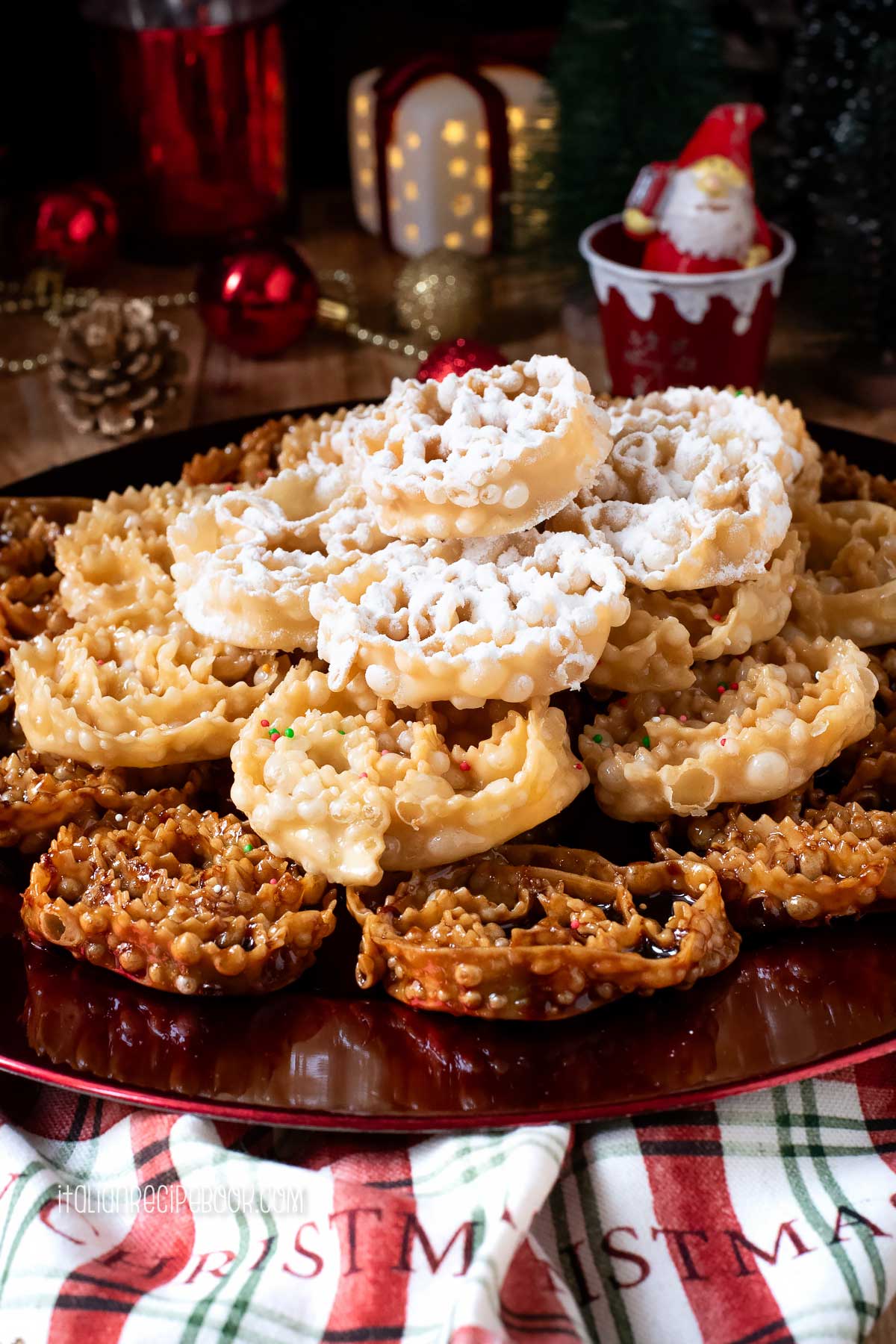
Just like Struffoli in Campgna, Cantucci in Tuscany, Cartellate cannot miss on Christmas tables in Apulia. It’s an age-old tradition that was literally engraved on the rocks.
According to popular beliefs their form represents the swaddling clothes of Baby Jesus when he was born.
Near the city of Bari, a rock painting from the 6th BC was found that depicts the preparation of sweets very similar to these, made as votive offerings to be donated to the Gods.
Their name seems to be connected with the Italian word carta, meaning paper, because their shape reminds of a beautiful arabesque made with a thin sheet of paper.
Table Of Contents
Recipe In A Nutshell
- Prepare the dough, let rest for 1 hour.
- Pass the dough through pasta machine to “laminate” it.
- Using pasta machine roll the dough into thin sheets.
- Cut with a serrated pasta wheel into 1.5 x12 inch (4x30cm) strips. Pinch each 1.5-2 inches (4–5cm) and wrap around themselves forming a rose or pinwheel shape.
- Let dry for 6 hours or overnight.
- Fry in hot oil and let cool.
- Dip cartellate in honey or vincotto or simply dust with powdered sugar.
RECIPE YIELD: 25-30 cartellate.
This recipe makes a nice easily manageable batch if it’s your first time making them. It’s good for a company of 4. Making them the second time you can double or even triple the recipe.
Ingredients
See the recipe card for full information on ingredients and quantities.
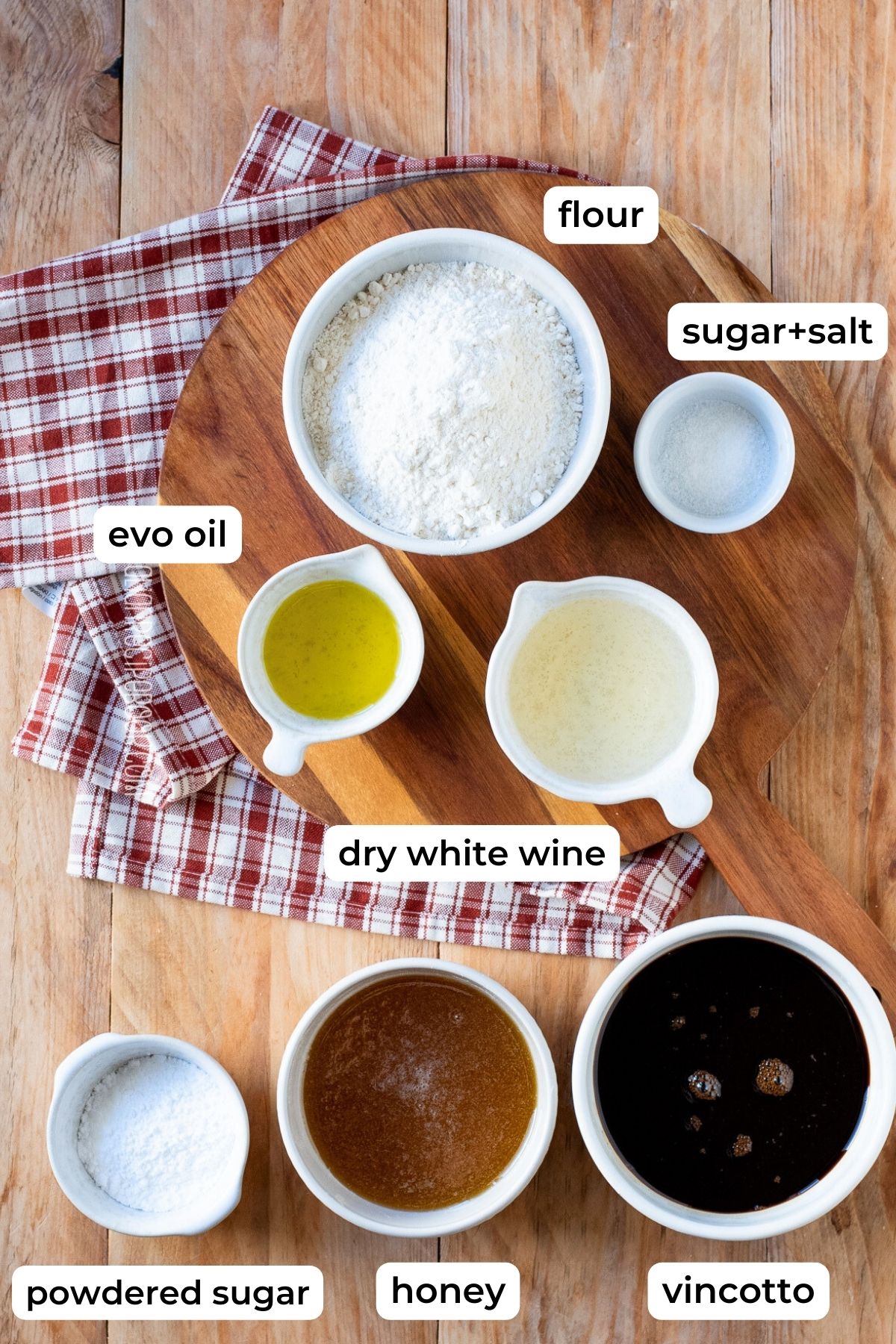
For the dough
- Flour - Italian 00 flour is the best, but you can't find it use all purpose. You might need to slightly adjust the amount.
- Dry white wine - use quality, medium priced dry white wine. No need to buy the most expensive but also don't buy one sold in carton bricks. It's too acidic.
- Sugar - using very little as the condiment (vincotto or honey) will provide the most sweetness.
- Salt - a pinch only.
- Extra virgin olive oil (EVO oil) - gives flavor and characteristic bubbly and crispy texture. You won't need much so use the high quality one.
For coating
Choose one of the below or do a mix of all.
- Vincotto - in Puglia traditionally fig vincotto is used to coat cartellate but you can use grape vincotto (including homemade!) also known as cooked grape must or saba interchangeably. PAY ATTENTION it is NOT a vincotto vinegar.
Another alternative is a fig syrup like this one. - Honey - easily available and absolutely delicious. Make sure to use high quality natural honey.
- Powdered sugar - the easiest alternative if you won't want to soak cartellate in vincotto or honey or simply want to make a mix.
- Chocolate - a rather modern twist on traditional cartellate. Melt some quality chocolate and using a zip-lock bag with a cut angle drizzle over cartellate. Some like to dip them in chocolate sauce whole as you would do with honey but that's probably an exaggeration.
How To Make - Step By Step With Pictures
Prepare the dough
- In a small pot warm the wine with the sugar and a pinch of salt until warm.
- Mound flour on work-surface or in a bowl. Add extra virgin olive oil. Mix quickly then start adding wine, a little at a time.
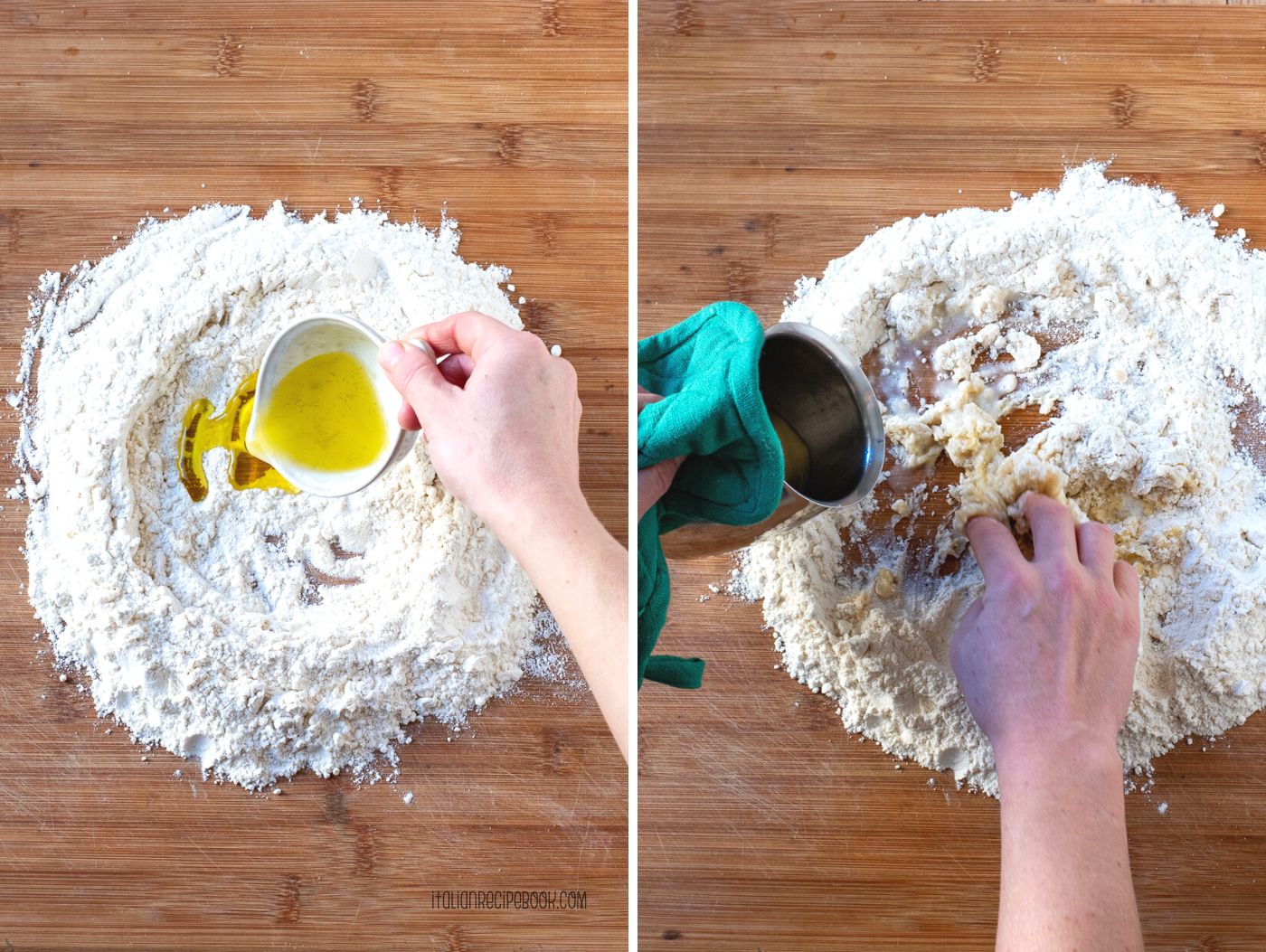
- Knead the dough briefly until it comes into a ball. As a result you should have a soft but not excessively soft ball of dough that will look slightly irregular but overall compact.
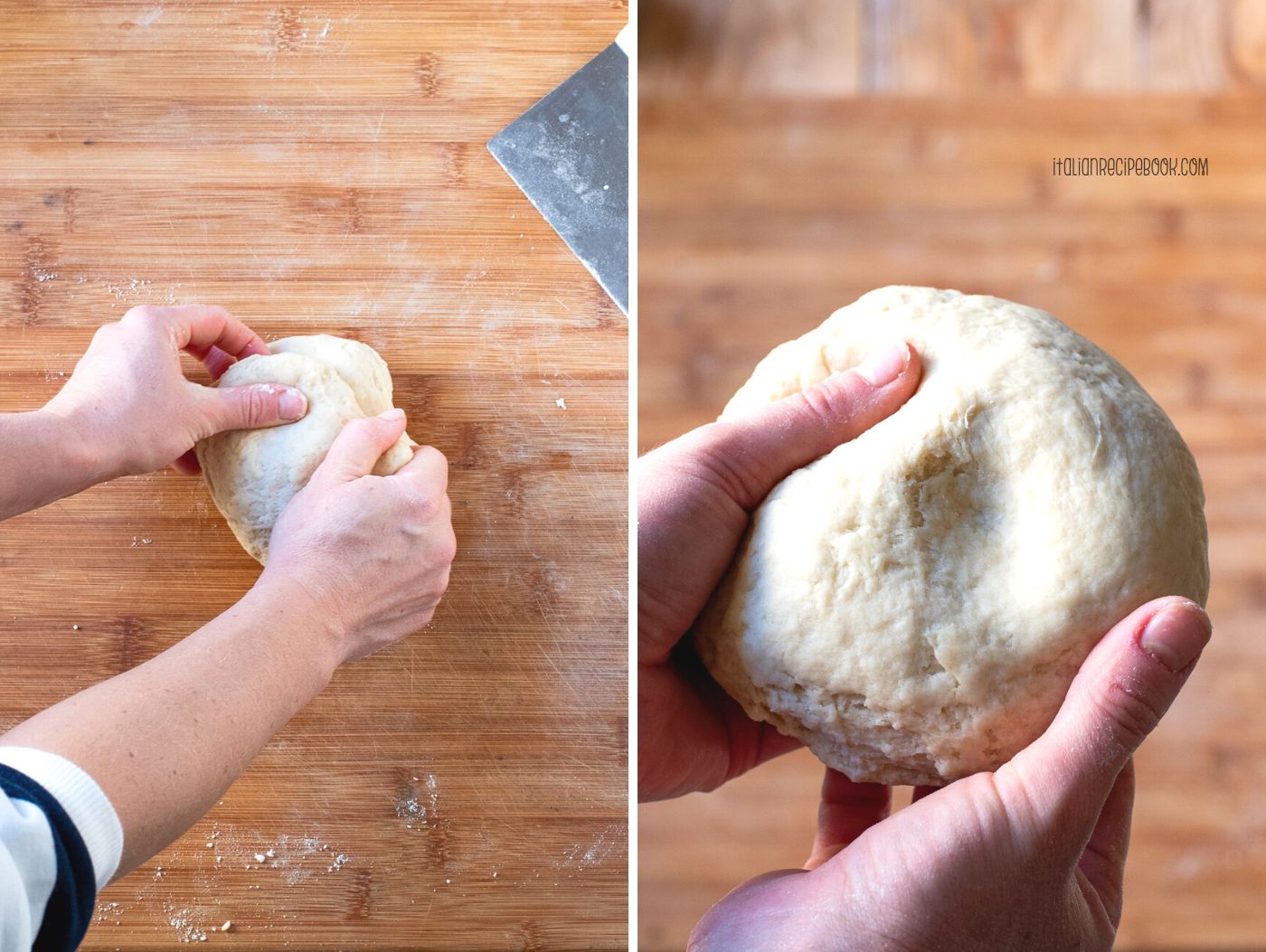
Laminate the dough
- Once the dough has rested divide it into 2 parts.Using a rolling pin flatten the first piece of the dough roughly forming a rectangular that will fit the size of the pasta machine rollers.
Keep the other piece of the dough in a plastic wrap to prevent it from drying. - Set pasta machine on the widest setting (on Marcato Atlas 0) and pass the dough for the first time. Dust with extra flour if the dough is a little sticky.
- Fold the dough in half and pass again on the same setting. Repeat rolling and folding process 6 times. This step is creating a sort of “laminated” dough (thing like croissants) that later when fried will result in supercrispy, airy and bubbly cartellate.

- Wrap the “laminated” dough in a plastic wrap and repeat the same process with the other piece of the dough.
Roll out the dough
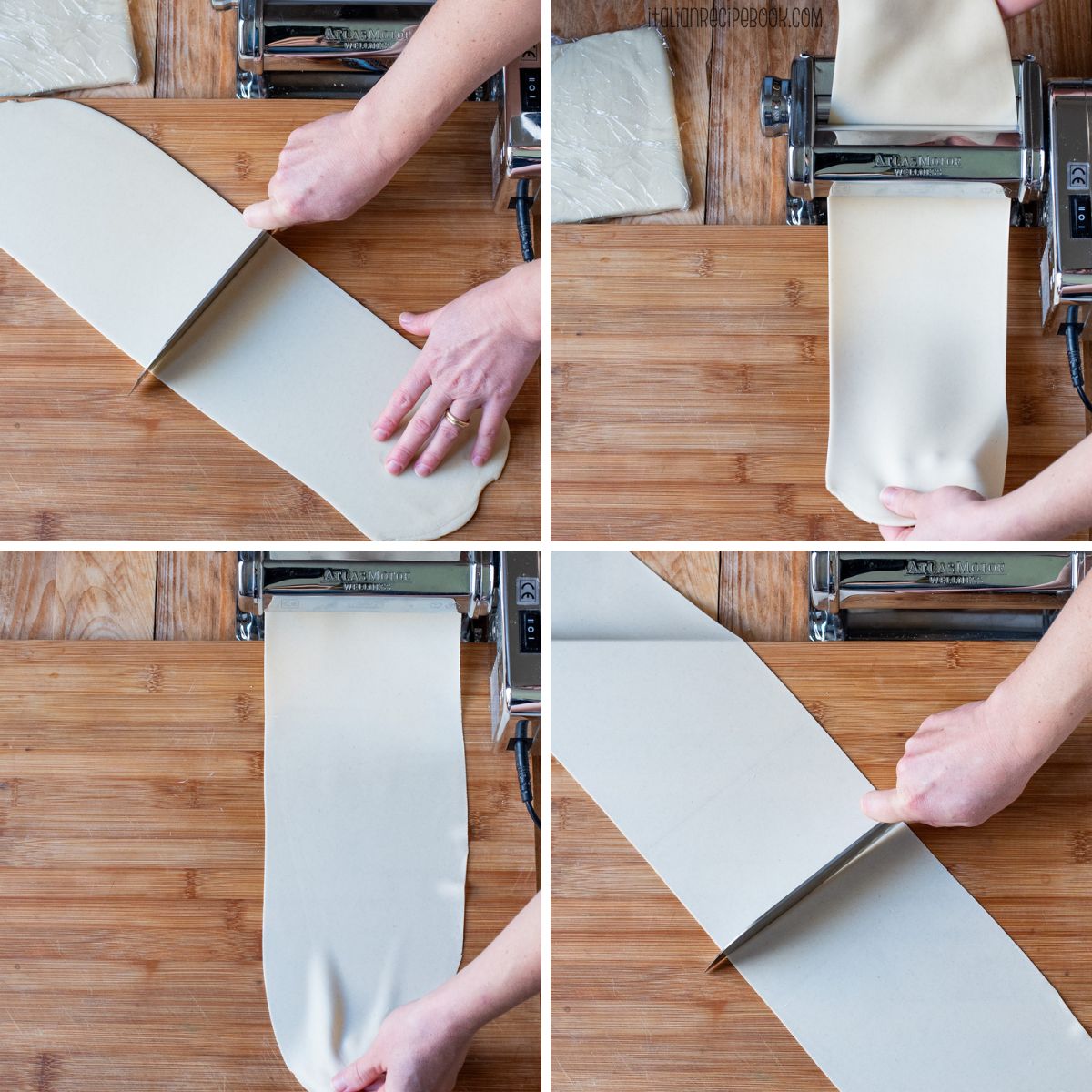
- Start working with the piece of the dough you’ve laminated first.
- Roll it on the widest setting of your pasta machine the adjust to the next-narrower setting, and pass the dough through it. Repeat the process until you reach thickness of 1.5 millimeter or position 5 on Marcato Atlas Pasta Machine.
EXTRA TIP: if the dough on setting 3 (2.5 mm) is about 6 inch (15 cm) long cut it in half. Then pass each half on the setting 4 and 5. This way the dough is easier to handle when rolling it through the pasta machine.
- Cut the dough sheet into about 12 inch (30cm) pieces.
Shape Cartellate
- Using a serrated wheel to cut each sheet into 1.5 inch (4 cm) strips
- Pinch together the sides of the dough strip every 1.5-2 inches (4-5cm).
When doing the next pinch, hold the first one with one hand and do the the next pinch with the other hand bringing the two a little closer to each other. This move will form a pocket between the two pinches.

- Once you’ve finished pinching the strip, wrap it around itself forming kind of a rose shape or a pinwheel.
Start by pinching the first two pockets together, then the next.
AVOID tightening cartellate too much. This will result in flat pockets which are essential for holding the sauce. Also avoid pinching together already sealed parts but rather pinch parts inside the pocket where the dough is in single layer.
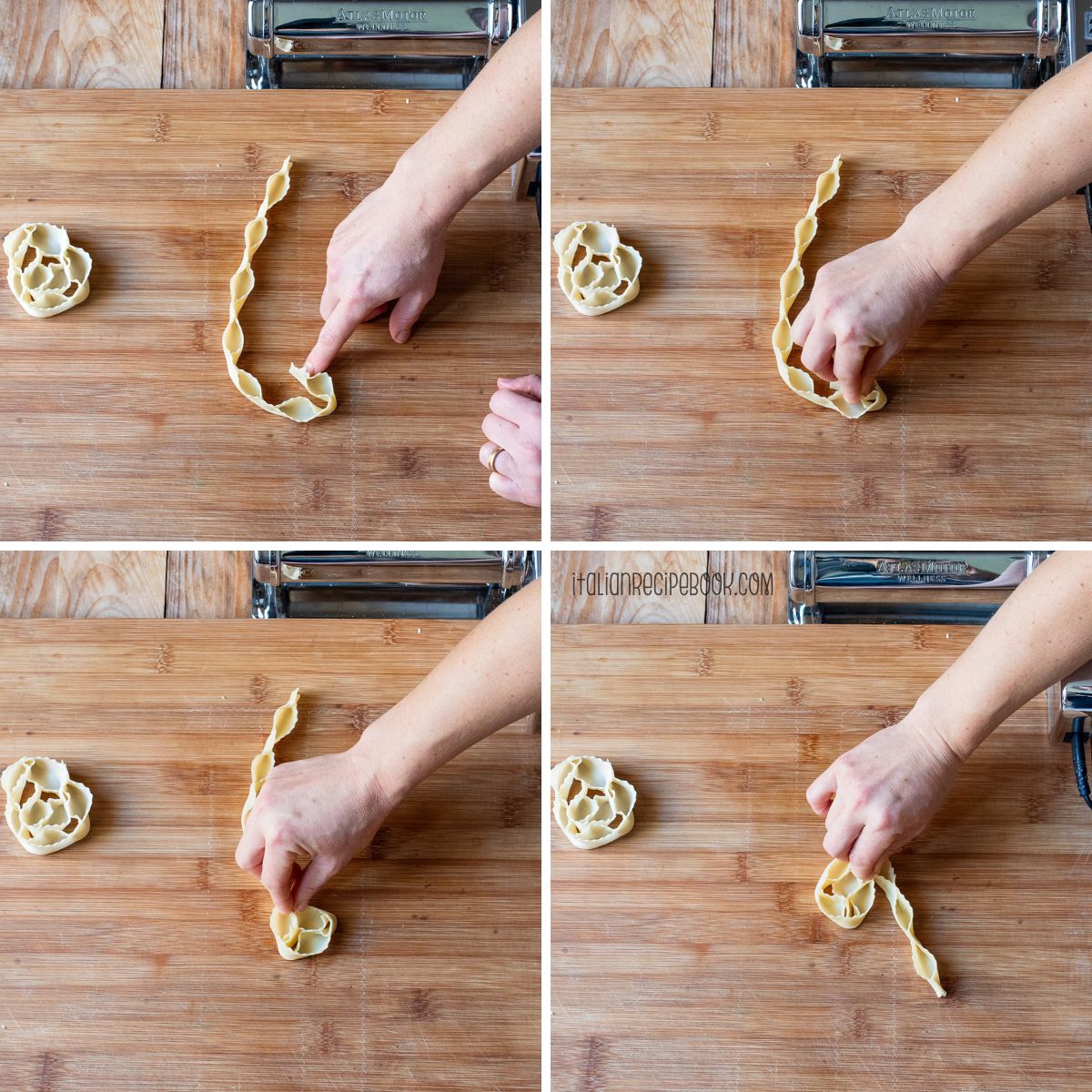
- Repeat the process with the remaining strips.
EXTRA TIP: If it’s your first time making cartellate and the dough strips started to dry and won’t stray together when pinched, tap them with damp paper towel rolling in a a ball. - Repeat the process with the remaining dough (starting from the previous step: rolling out the dough).
EXTRA TIP: It’s best to roll out the dough and form cartellate in small batches so that you can form cartellate easily.
Let Dry
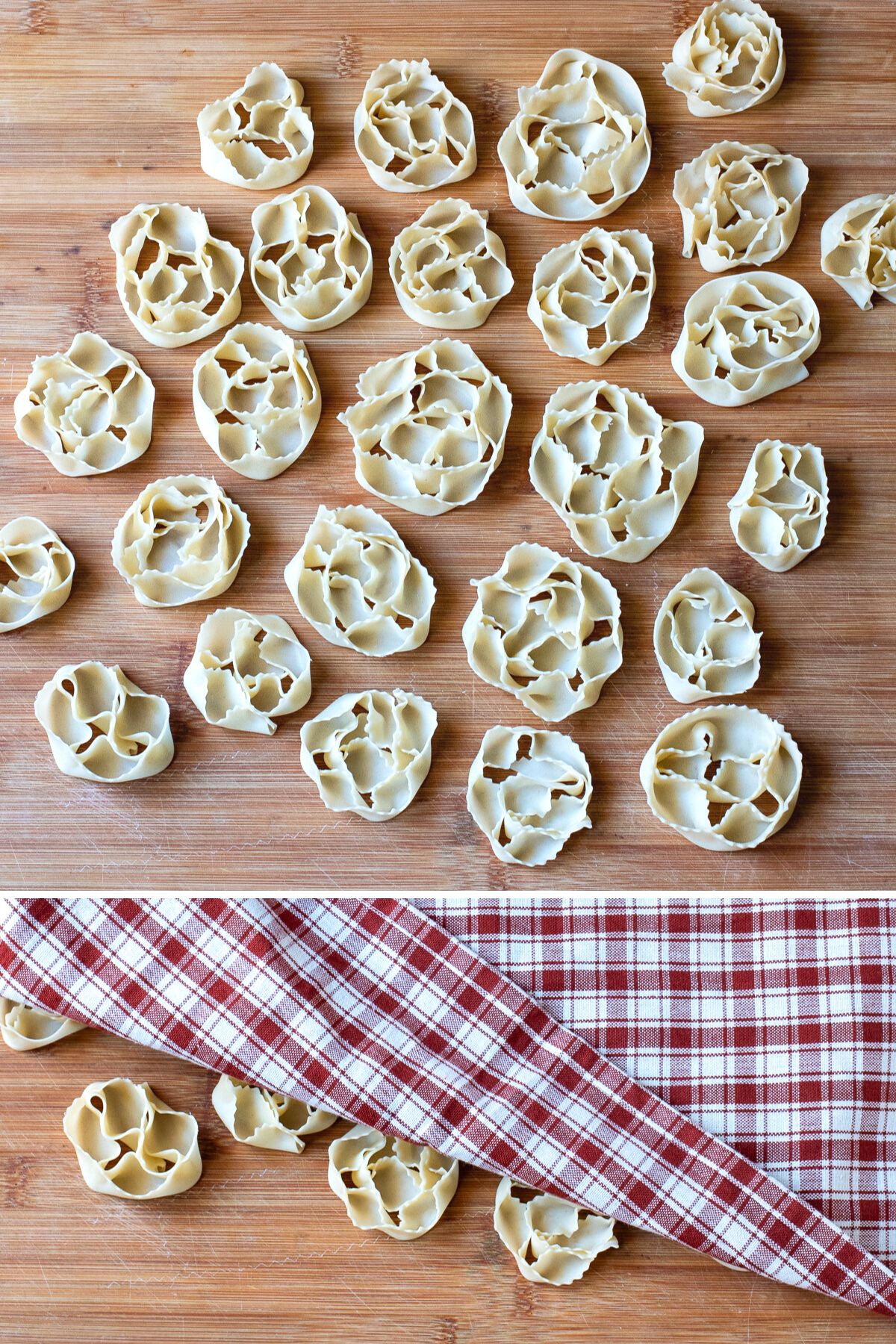
- Once all cartellate a formed arrange them on a wooden board and cover with a linen towel or tea towel. Let rest for 6 hours or overnight.
- After 2 hours move cartellate around to make sure they’re not stuck to the board (which rare happens but a good practice to do). It’s best NOT to flour the board.
The resting time that long is essential to let cartellate dry, which in turn will prevent them from absorbing excess oil AND unwraping when fried.
HOW DRY? Cartellata should hold its shape without bending even you hold if with only two fingers. There's NO need to dry them completely.
Fry Cartellate
- In a deep frying pan preheat vegetable oil for frying to 350F (175C). It’s best to use a kitchen thermometer to control the temperature throughout the frying process and adjusting the heat as needed.
PAY ATTENTION: the level of oil in the pan should be at least 2 fingers. The more oil in the pan the less oil cartellate will absorb.
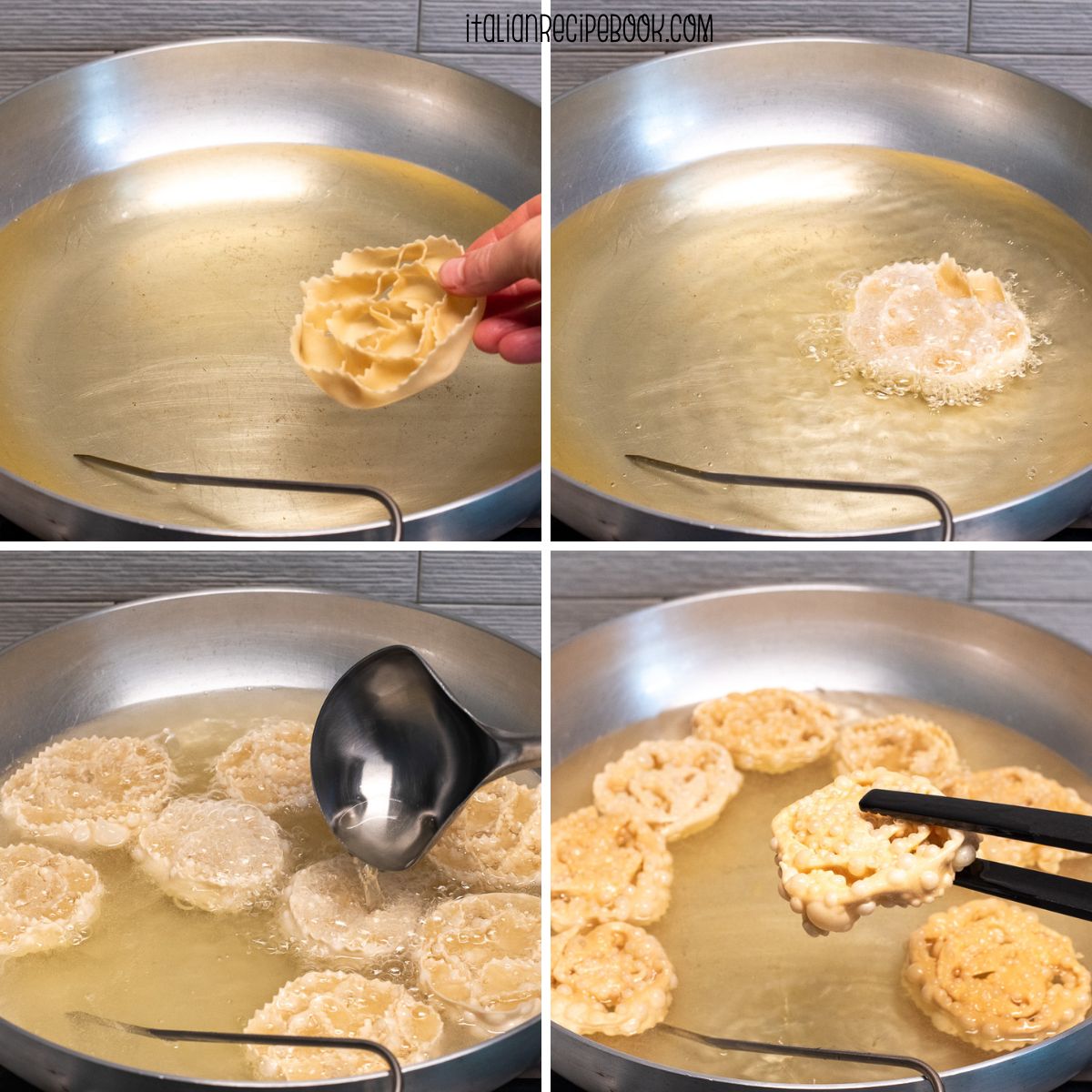
- Once oil is hot enough fry cartellate. Using a spoon or a ladle pour hot oil over each cartellata to help them form bubbles and fry evenly. Flip cartellate throughout the fryin process. When lightly golden brown pick them with tongs draining oil from the pockets. Arrange on paper towels upside down.
- Bring the oil back to 350 (175C) and fry the next batch.
Dip in the sauce
Vincotto Sauce

In a small pot add vincotto and bring to a boil. Take note if your vincotto was creamy or runny when it was cold. Let cook vincotto on low heat for 5 minutes (for initially creamy vincotto) or for 10-12 minutes (for initially runny vincoto).
PAY ATTENTION: hot vincotto is always thinner than vincotto at room temperature. So pay attention to not overcook it!
Dip cartellate in hot vincotto letting drip the excess. If vincotto is of the right consistency it will stay in the pockets of cartellate and will thicken as they cool. Don’t leave too much vincotto in the pockets or cartellate will become excessively sweet. If the sauce is too thin you can cook it for a few more minutes.
Honey Sauce
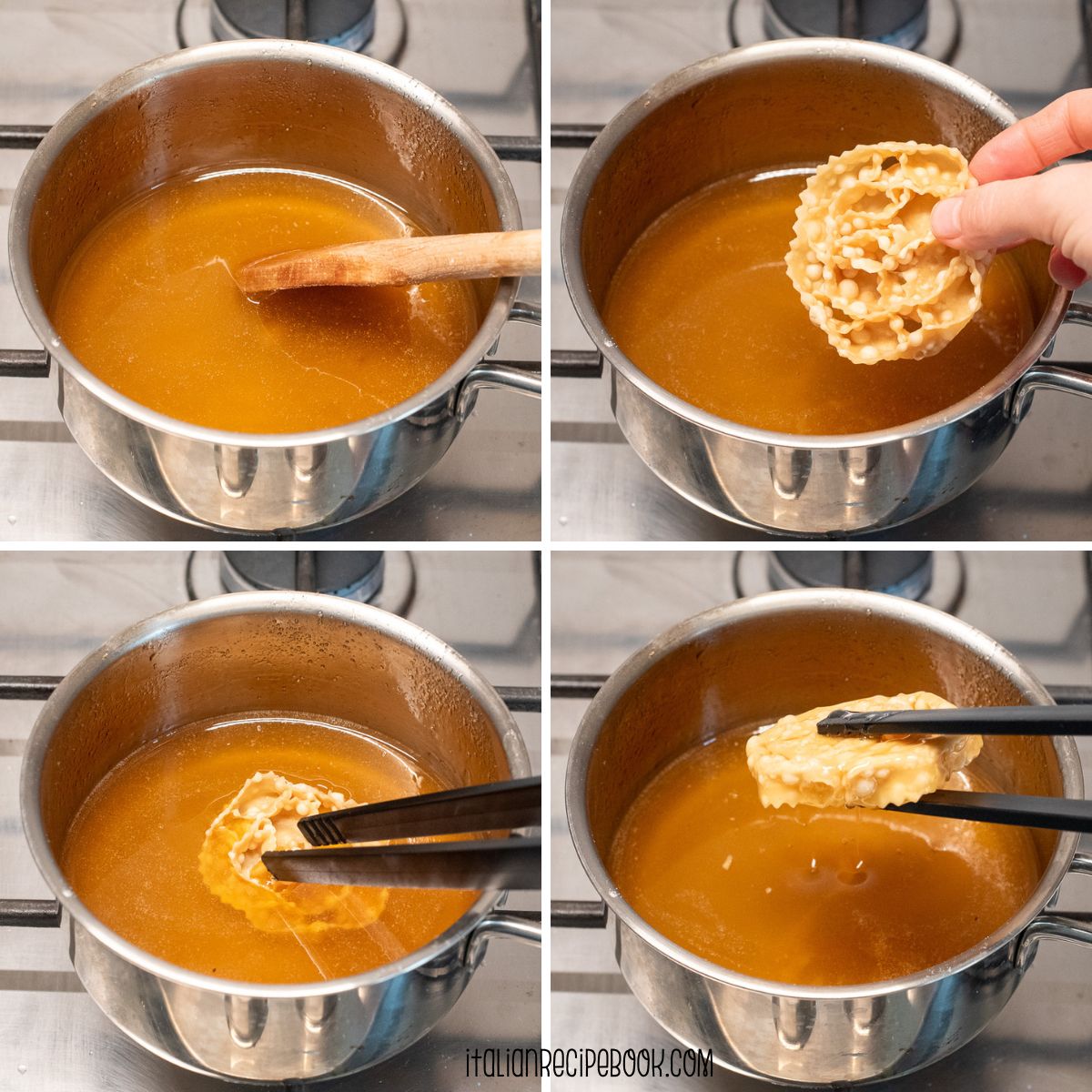
In a small pot add honey and warm up on gentle heat until well warm. Dip each cartellata in honey letting drip the excess.
Sprinkle with a few sugar sprinkles (optional).
Powdered Sugar
If you don’t want to deal with the sauce or want to do a mix and match of sauce, you can also dust cartellate with powdered sugar. They turn out absolutely delicious and remind a lot Italian Carnival Chiacchiere (Crostoli).
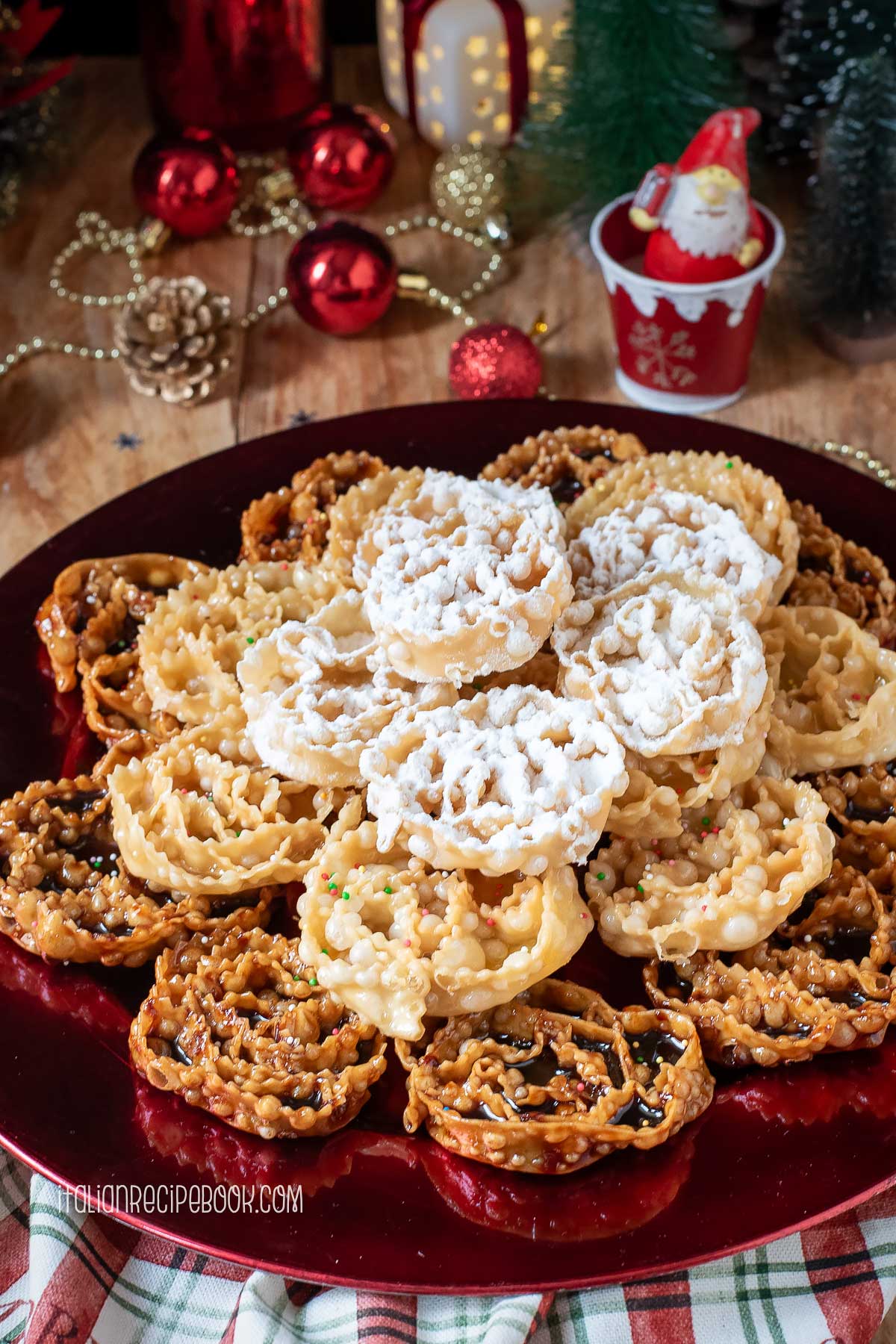
How To Store
Cartellate coated in vincotto or honey will keep at room temperature for up to 3 days.
Make Ahead
You can prepare cartellate up to 1 week in advance. Deep fry, let cool and store in an airtight container or a well sealed plastic bag. One or two days before serving prepare honey or vincotto and dip cartellate.
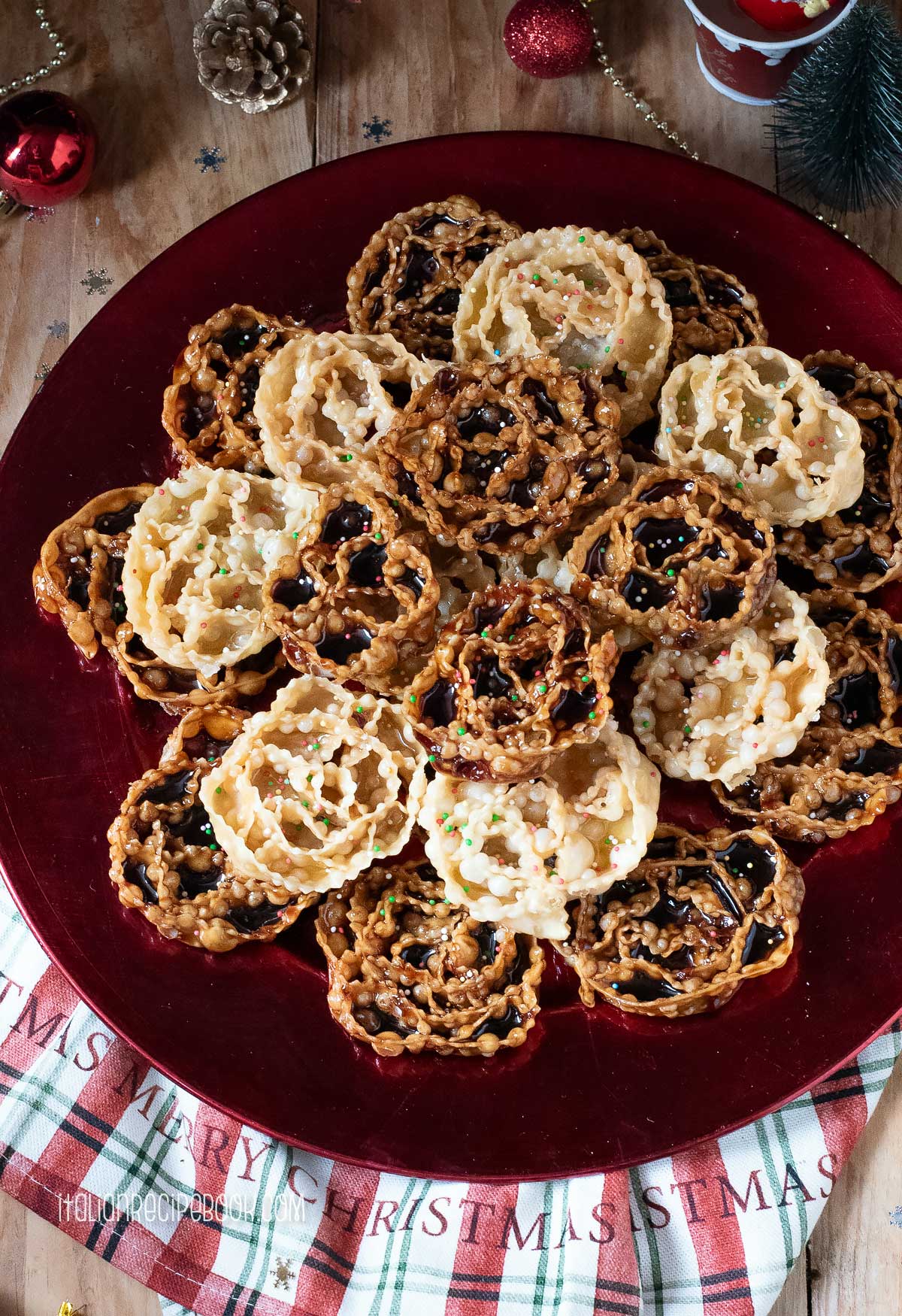
More Italian Christmas Desserts

Love Italian Food?
Sign up for our weekly newsletter to receive tips, tricks and new recipes delivered straight to your inbox!
Full Recipe

Cartellate - Christmas Fritters Dipped in Honey Or Vincotto
Equipment
- serrated wheel
Ingredients
For the dough
- 300 grams Italian 00 flour , or all-purpose flour 2 ⅓ cups
- 100 grams dry white wine , about ⅓ cup + 2 tablespoon (warmed)
- 45 grams extra virgin olive oil , ¼ cup
- 1 teaspoon sugar
- Pinch of salt
For the sauce (choose ONE or do all)
- 1 ½ cup vincotto , see ingredient notes above
- 1 ½ cup natural honey , wildflower or other
- Powdered sugar
- Sugar sprinkles for decoration (optional)
Instructions
Prepare the dough
- In a small pot warm the wine with the sugar and a pinch of salt until warm.
- Mound flour on work-surface or in a bowl. Add extra virgin olive oil. Mix quickly then start adding wine, a little at a time. Knead the dough briefly until it comes into a ball. As a result you should have a soft but not excessively soft ball of dough that will look slightly irregular but overall compact.
- Place the dough in a plastic wrap or zip-lock bag and let rest for 1 hour.
Laminate the dough
- Once the dough has rested divide it into 2 parts.Using a rolling pin flatten the first piece of the dough roughly forming a rectangular that will fit the size of the pasta machine rollers.Keep the other piece of the dough in a plastic wrap to prevent it from drying.
- Set pasta machine on the widest setting (on Marcato Atlas setting 0) and pass the dough for the first time. Dust with extra flour if the dough is a little sticky. Fold the dough in half and pass again on the same setting. Repeat rolling and folding process 6 times. This step is creating a sort of “laminated” dough (think like croissants) that later when fried will result in super crispy, airy and bubbly cartellate.
- Wrap the “laminated” dough in a plastic wrap and repeat the same process with the other piece of the dough.
Roll out the dough
- Start working with the piece of the dough you’ve laminated first.
- Roll it on the widest setting of your pasta machine then adjust to knob the next-narrower setting, and pass the dough through it. Repeat the process until you reach thickness of 1.5 millimeter (setting 5 on Marcato Atlas Pasta Machine).EXTRA TIP: if the dough on setting 3 (2.5 mm) is about 6 inch (15 cm) long cut it in half. Then pass each half on the setting 4 and 5. This way the dough is easier to handle when rolling it through the pasta machine.
- Cut the dough sheet into about 12 inch (30cm) sheets.
Shape Cartellate
- Using a serrated wheel cut each sheet into 1.5 inch (4 cm) strips.Each strip should measure roughly 1.5x12 inch (4x30 cm).
- Pinch together the sides of the dough strip every 1.5-2 inches (4-5cm).When doing the next pinch, hold the first one with one hand and do the the next pinch with the other hand bringing the two a little closer to each other. This move will form a pocket between the two pinches.
- Once you’ve finished pinching the strip, wrap it around itself forming kind of a rose shape or a pinwheel.Start by pinching the first two pockets together, then the next ones.AVOID tightening cartellate too much. This will result in flat pockets which are essential for holding the sauce. Also avoid pinching together already sealed parts but rather pinch parts inside the pocket where the dough is in single layer.
- Repeat the process with the remaining strips.EXTRA TIP: If it’s your first time making cartellate and the dough strips started to dry and won’t stray together when pinched, tap them with damp paper towel rolling in a a ball.
- Repeat the process with the remaining dough (starting from the previous sections "Rolling out the dough").EXTRA TIP: It’s best to roll out the dough and form cartellate in small batches so that you can form cartellate easily.
Let Cartellate Dry
- Once all cartellate a formed arrange them on a wooden board and cover with a linen towel or tea towel. Let rest for 6 hours or overnight.
- After 2 hours move cartellate around to make sure they’re not stuck to the board (which rare happens but a good practice to do). It’s best NOT to flour the board.
- The resting time that long is essential to let cartellate dry, which in turn will prevent them from absorbing excess oil AND unwrapping when fried.How dry? It should hold its shape without bending even you hold if with only two fingers. There's NO need to dry them completely.
Fry Cartellate
- In a deep frying pan preheat vegetable oil for frying to 350F (175C). It’s best to use a kitchen thermometer to control the temperature throughout the frying process and adjusting the heat as needed.PAY ATTENTION: the level of oil in the pan should be at least 3 fingers. The more oil in the pan the less oil cartellate will absorb.
- Once oil is hot enough fry cartellate. Using a spoon or a ladle pour hot oil over each cartellata to help them form bubbles and fry evenly. Flip cartellate throughout the fryin process. When lightly golden brown pick them with tongs draining oil from the pockets. Arrange on paper towels upside down.
- Bring the oil back to 350 (175C) and fry the next batch.
Dip In The Sauce
- Vincotto Sauce: In a small pot add vincotto and bring to a boil. Take note if your vincotto was creamy or runny when it was cold. Let cook vincotto on low heat for 5 minutes (for initially creamy vincotto) or for 10-12 minutes (for initially runny vincoto).PAY ATTENTION: hot vincotto is always thinner than vincotto at room temperature. So pay attention to not overcook it!Dip cartellate in hot vincotto letting drip the excess. If vincotto is of the right consistency it will stay in the pockets of cartellate and will thicken as they cool. Don’t leave too much vincotto in the pockets or cartellate will become excessively sweet. If the sauce is too thin you can cook it for a few more minutes.
- Honey Sauce: In a small pot add honey and warm up on gentle heat until well warm. Dip each cartellata in honey letting drip the excess.
- Sprinkle with a few sugar sprinkles (optional).
- Powdered Sugar: If you don’t want to deal with the sauce or want to do a mix and match of sauce, you can also dust cartellate with powdered sugar.
Nutrition
Nutrition information is automatically calculated, so should only be used as an approximation.
Merry Christmas & Buon Natale!









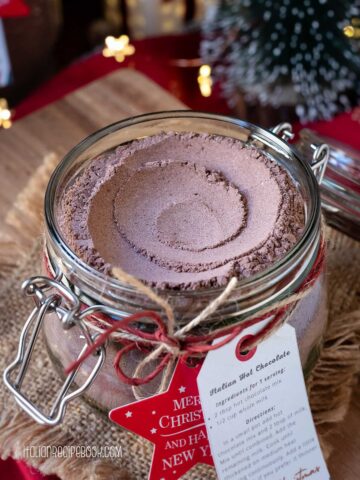
Montillo Italian Foods says
Thank you for sharing your Christmas cartellate recipe. I love the detail you included. I hope you don't mind if I offer one minor correction. You mentioned that in Puglia they "traditionally use fig vincotto to coat cartellate but you can use grape vincotto." Actually, both grape vincotto and fig vincotto can be used for cartellate, but grape vincotto (also known as vino cotto in southern Italy) is the more traditional choice. Merry Christmas & Happy New Year!
Bunny Antal says
When do you put nuts on them like it shows in the picture.